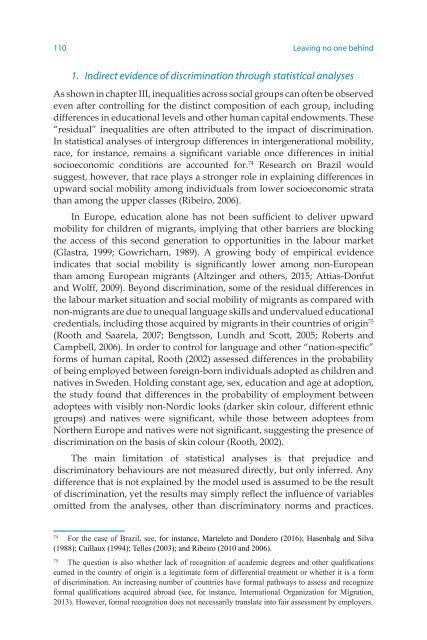Leaving no one behind the imperative of inclusive development
full-report
full-report
You also want an ePaper? Increase the reach of your titles
YUMPU automatically turns print PDFs into web optimized ePapers that Google loves.
110<br />
<strong>Leaving</strong> <strong>no</strong> <strong>one</strong> <strong>behind</strong><br />
1. Indirect evidence <strong>of</strong> discrimination through statistical analyses<br />
As shown in chapter III, inequalities across social groups can <strong>of</strong>ten be observed<br />
even after controlling for <strong>the</strong> distinct composition <strong>of</strong> each group, including<br />
differences in educational levels and o<strong>the</strong>r human capital endowments. These<br />
“residual” inequalities are <strong>of</strong>ten attributed to <strong>the</strong> impact <strong>of</strong> discrimination.<br />
In statistical analyses <strong>of</strong> intergroup differences in intergenerational mobility,<br />
race, for instance, remains a significant variable once differences in initial<br />
socioeco<strong>no</strong>mic conditions are accounted for. 74 Research on Brazil would<br />
suggest, however, that race plays a stronger role in explaining differences in<br />
upward social mobility among individuals from lower socioeco<strong>no</strong>mic strata<br />
than among <strong>the</strong> upper classes (Ribeiro, 2006).<br />
In Europe, education al<strong>one</strong> has <strong>no</strong>t been sufficient to deliver upward<br />
mobility for children <strong>of</strong> migrants, implying that o<strong>the</strong>r barriers are blocking<br />
<strong>the</strong> access <strong>of</strong> this second generation to opportunities in <strong>the</strong> labour market<br />
(Glastra, 1999; Gowricharn, 1989). A growing body <strong>of</strong> empirical evidence<br />
indicates that social mobility is significantly lower among <strong>no</strong>n-European<br />
than among European migrants (Altzinger and o<strong>the</strong>rs, 2015; Attias-Donfut<br />
and Wolff, 2009). Beyond discrimination, some <strong>of</strong> <strong>the</strong> residual differences in<br />
<strong>the</strong> labour market situation and social mobility <strong>of</strong> migrants as compared with<br />
<strong>no</strong>n-migrants are due to unequal language skills and undervalued educational<br />
credentials, including those acquired by migrants in <strong>the</strong>ir countries <strong>of</strong> origin 75<br />
(Rooth and Saarela, 2007; Bengtsson, Lundh and Scott, 2005; Roberts and<br />
Campbell, 2006). In order to control for language and o<strong>the</strong>r “nation-specific”<br />
forms <strong>of</strong> human capital, Rooth (2002) assessed differences in <strong>the</strong> probability<br />
<strong>of</strong> being employed between foreign-born individuals adopted as children and<br />
natives in Sweden. Holding constant age, sex, education and age at adoption,<br />
<strong>the</strong> study found that differences in <strong>the</strong> probability <strong>of</strong> employment between<br />
adoptees with visibly <strong>no</strong>n-Nordic looks (darker skin colour, different ethnic<br />
groups) and natives were significant, while those between adoptees from<br />
Nor<strong>the</strong>rn Europe and natives were <strong>no</strong>t significant, suggesting <strong>the</strong> presence <strong>of</strong><br />
discrimination on <strong>the</strong> basis <strong>of</strong> skin colour (Rooth, 2002).<br />
The main limitation <strong>of</strong> statistical analyses is that prejudice and<br />
discriminatory behaviours are <strong>no</strong>t measured directly, but only inferred. Any<br />
difference that is <strong>no</strong>t explained by <strong>the</strong> model used is assumed to be <strong>the</strong> result<br />
<strong>of</strong> discrimination, yet <strong>the</strong> results may simply reflect <strong>the</strong> influence <strong>of</strong> variables<br />
omitted from <strong>the</strong> analyses, o<strong>the</strong>r than discriminatory <strong>no</strong>rms and practices.<br />
74<br />
For <strong>the</strong> case <strong>of</strong> Brazil, see, for instance, Marteleto and Dondero (2016); Hasenbalg and Silva<br />
(1988); Caillaux (1994); Telles (2003); and Ribeiro (2010 and 2006).<br />
75<br />
The question is also whe<strong>the</strong>r lack <strong>of</strong> recognition <strong>of</strong> academic degrees and o<strong>the</strong>r qualifications<br />
earned in <strong>the</strong> country <strong>of</strong> origin is a legitimate form <strong>of</strong> differential treatment or whe<strong>the</strong>r it is a form<br />
<strong>of</strong> discrimination. An increasing number <strong>of</strong> countries have formal pathways to assess and recognize<br />
formal qualifications acquired abroad (see, for instance, International Organization for Migration,<br />
2013). However, formal recognition does <strong>no</strong>t necessarily translate into fair assessment by employers.
















